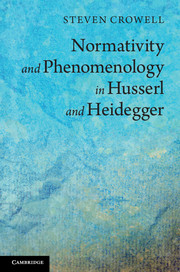Book contents
- Frontmatter
- Contents
- Acknowledgments
- Citation conventions for the works of Husserl and Heidegger
- Introduction
- Part I Transcendental philosophy, phenomenology, and normativity
- 1 Making meaning thematic
- 2 Husserlian phenomenology
- 3 The matter and method of philosophy
- Part II Husserl on consciousness and intentionality
- Part III Heidegger, care, and reason
- Part IV Phenomenology and practical philosophy
- References
- Index
3 - The matter and method of philosophy
Published online by Cambridge University Press: 05 April 2013
- Frontmatter
- Contents
- Acknowledgments
- Citation conventions for the works of Husserl and Heidegger
- Introduction
- Part I Transcendental philosophy, phenomenology, and normativity
- 1 Making meaning thematic
- 2 Husserlian phenomenology
- 3 The matter and method of philosophy
- Part II Husserl on consciousness and intentionality
- Part III Heidegger, care, and reason
- Part IV Phenomenology and practical philosophy
- References
- Index
Summary
“Phenomenology, that’s Heidegger and I – and no one else.” According to legend Husserl spoke these words in the early 1920s, when he was at the height of his fame in Freiburg and Heidegger, his young assistant, was grappling with the ideas that would become Being and Time. In 1927 Heidegger dedicated that work to Husserl “in respect and friendship,” writing in a footnote that “[i]f the following investigation has taken a few steps forward in disclosing the ‘things themselves,’ the author must first of all thank E. Husserl, who, by providing his own incisive personal guidance and by freely turning over his unpublished investigations, familiarized the author with the most diverse areas of phenomenological research during his student years in Freiburg” (GA 2, p. 52/38/489). But in 1923 he was writing privately to Karl Löwith that “I am now convinced that Husserl was never a philosopher, not even for one second in his life” (Husserl 1997, p. 17). And while dedicating Being and Time to his mentor, Heidegger was writing to Karl Jaspers that “if the treatise has been written ‘against’ anyone, then it has been written against Husserl” (Husserl 1997, p. 22). For his part, Husserl struggled to understand how Heidegger’s work fit into his own project of transcendental phenomenology and ultimately came to the conclusion that it did not: “my antipodes, Scheler and Heidegger,” he wrote to Roman Ingarden in 1931 (Husserl 1968, p. 67).
- Type
- Chapter
- Information
- Normativity and Phenomenology in Husserl and Heidegger , pp. 58 - 78Publisher: Cambridge University PressPrint publication year: 2013



